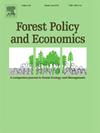土地所有者在美国交叉木材森林中采取积极管理措施的意愿
IF 3.8
2区 农林科学
Q1 ECONOMICS
引用次数: 0
摘要
交叉森林(CT)位于美国南部大平原东部森林和西部草原之间的过渡生态区,为俄克拉荷马州、德克萨斯州和堪萨斯州的居民提供了许多生态系统服务。日益增长的气候变化、数十年的灭火、木本植物的入侵、人为活动以及明显缺乏主动管理已经改变了这些森林的原始组成。由于大多数CT林地为私人所有,因此了解影响林地所有者实施主动森林经营意愿的因素非常重要。本研究通过对CT地区林地所有者的混合模式调查,调查了土地所有者对两种关键森林管理做法——间伐和规定焚烧的偏好。结果表明,林地所有者的间伐意愿受林地所有者年龄、林地持有规模和木本植物入侵状况的显著影响。同样,土地所有者采取规定焚烧的意愿也受到林地持有规模、木本植物侵占状况、教育水平、非木材所有权目标(如野生动物栖息地管理、休闲狩猎和捕鱼、土地投资)的显著影响。这些研究结果有助于利益相关者确定这些管理实践的可能或不可能的适应者,启动或定制教育计划,针对相关受众的推广和外展战略,以及采取可以促进CT森林可持续管理的政策。本文章由计算机程序翻译,如有差异,请以英文原文为准。
Landowner willingness to adopt active management practices in the Cross-Timbers forests in USA
Cross-Timbers (CT) forests, located in a transition ecoregion between eastern forests and western grasslands of the southern Great Plains of the United States, provide numerous ecosystem services to the residents of Oklahoma, Texas, and Kansas. Growing climate variability, decades of fire suppression, woody plant encroachment, anthropogenic activities, and notable lack of active management have altered the original composition of these forests. As most CT forestlands are privately owned, understanding the factors influencing landowners' willingness to implement active forest management is very important. This study investigated landowner preferences regarding thinning and prescribed burning, which are two key forest management practices –– through a mixed-mode survey of forestland owners in the CT region. Results suggested that landowners' willingness to adopt thinning is significantly influenced by the age of forest landowners, forest land holding size, and status of encroachment by woody plants. Similarly, landowners' willingness to adopt prescribed burning is significantly influenced by forest land holding size, status of encroachment by woody plants, education level, and non-timber ownership objectives such as wildlife habitat management, recreational hunting and fishing, and land investment. These findings are useful to stakeholders in identifying likely or unlikely adaptors of these management practices, initiating or tailoring educational programs, Extension and outreach strategies to relevant audience, and adopting policies that can promote sustainable management of CT forests.
求助全文
通过发布文献求助,成功后即可免费获取论文全文。
去求助
来源期刊

Forest Policy and Economics
农林科学-林学
CiteScore
9.00
自引率
7.50%
发文量
148
审稿时长
21.9 weeks
期刊介绍:
Forest Policy and Economics is a leading scientific journal that publishes peer-reviewed policy and economics research relating to forests, forested landscapes, forest-related industries, and other forest-relevant land uses. It also welcomes contributions from other social sciences and humanities perspectives that make clear theoretical, conceptual and methodological contributions to the existing state-of-the-art literature on forests and related land use systems. These disciplines include, but are not limited to, sociology, anthropology, human geography, history, jurisprudence, planning, development studies, and psychology research on forests. Forest Policy and Economics is global in scope and publishes multiple article types of high scientific standard. Acceptance for publication is subject to a double-blind peer-review process.
 求助内容:
求助内容: 应助结果提醒方式:
应助结果提醒方式:


